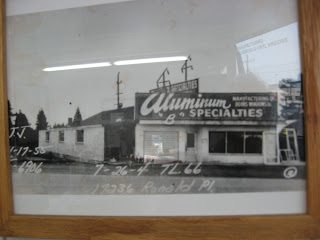a familiar style of architecture for folks who know the east side of Shoreline. Both Ridgecrest and Briarcrest have thousands of small homes built during this era.
The Ridgecrest Neighborhood has even been considered for recognition as a neighborhood by historic organizations, because of the unique preservation of these homes, which has stayed nearly the same as when they were built in the 1940-s and 50's.
These homes have become highly desirable for younger buyers, because they are relatively affordable,
have simple classic styling, and small yards for gardening buffs and are big enough for a small family.
After WW II, many veterans moved in to the Shoreline area, into these small homes with help from the G I Bill. So Ridgecrest is apparently at the height of preservation style! Who knew?
Washington State Dept. of Archaeology & Historic Preservation
Protect the Past, Shape the Future
http://wadahp.wordpress.com/2010/11/16/style-guide-wwii-era-cottages/
STYLE GUIDE: WWII ERA COTTAGES
WWII Era Cottage: 1935 – 1950
 The WWII Era Cottage resembles the Workingman’s Foursquare of the proceeding decade but utilized the latest advancements in spatial planning and building materials. The style serves as a transitional style bridging the gap between the Revival movement of the 1920s and the modern period leading up to and proceeding WWII.
The WWII Era Cottage resembles the Workingman’s Foursquare of the proceeding decade but utilized the latest advancements in spatial planning and building materials. The style serves as a transitional style bridging the gap between the Revival movement of the 1920s and the modern period leading up to and proceeding WWII.After WWII, with the peacetime economy just beginning to start up, materials were still in short supply. However the demand for housing was great, exacerbated by returning GI’s and their new families. As a response to the situation, new homes like the WWII Era Cottage were built in large quantities and featured little ornamentation. WWII Era Cottages are generally small (some less than 1,000 sq ft), and correspond to the small size of young families.
Most were built by speculative builders and purchased by families who took advantage of a variety of government incentive programs which were offered through the Federal Housing Administration. Because of their simplicity and low cost, WWII Era Cottages made the dream of home ownership possible for an unprecedented number of people.
 WWII Era Cottages, sometimes referred to as “Roosevelt Cottages”, are one-story structures covered by a hipped roof with minimal eave overhangs. The overall shape is typically square or rectangular in plan, although many boast more complex footprints that incorporate attached garages and shallow room projections. These projections can have hip or gable roofs. Large porches are generally absent; although a small covering or hood may be found over the front door, and/or a shallow stoop can be inserted into a projecting wing. The exteriors of these wood-framed buildings are sheathed with a wide range of materials from horizontal wood siding, wood shingles, stucco or brick, to asbestos ceramic shingles. Some concrete block and clay tile examples can be found. Higher end examples utilize a change in exterior material using the window sill as a breaking point.
WWII Era Cottages, sometimes referred to as “Roosevelt Cottages”, are one-story structures covered by a hipped roof with minimal eave overhangs. The overall shape is typically square or rectangular in plan, although many boast more complex footprints that incorporate attached garages and shallow room projections. These projections can have hip or gable roofs. Large porches are generally absent; although a small covering or hood may be found over the front door, and/or a shallow stoop can be inserted into a projecting wing. The exteriors of these wood-framed buildings are sheathed with a wide range of materials from horizontal wood siding, wood shingles, stucco or brick, to asbestos ceramic shingles. Some concrete block and clay tile examples can be found. Higher end examples utilize a change in exterior material using the window sill as a breaking point.WWII Era Cottages have a noticeable absence of stylistic ornamentation. However, early examples often have Art Deco or Streamlined Moderne elements such as glass block and rounded porch features. Wide frieze boards and vertical siding in gable ends might add a playful detail. Towards the late 1940s, brick and stone became common as decorative accents, particularly in the form of water tables and raised flower planters. Many have a single octagonal window on the main façade near the front entry door. Other windows are tall and wide, many retaining just horizontal muntin bars. Often windows are placed at the corners of the house and wrap around a side elevation.








From top: Seattle, Vancouver, Seattle, Bremerton, Pullman, Seattle, Spokane, Aberdeen
For More Information:
- Rifkind, Carole. A Field Guide to Contemporary American Architecture. A Dutton Book. New York, NY, 1998. pg 270-277.
- “A Puget Sound Home” Seattle Times, September 28, 1947. pg 18.
- “Small Homes Year Book” 1941 Show Edition.
- “Model Home in Modern” Pamphlet, 3rd Annual National Housing Exposition, Seattle, Febuary 1-9, 1941.
- Universal Small Homes: Book 21. Universal Plan Service, Portland, OR. 1950.
- Whiffen, Marcus. American Architecture Since 1780: A Guide to the Styles. 4th ed. MIT Press, Cambridge, Mass. 1996.
Posted in Style Guide
























